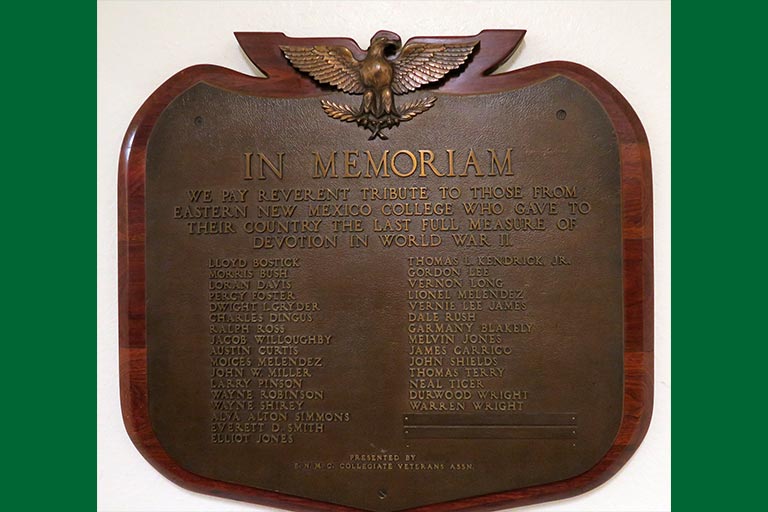"The Golden Years: 1928-1960," authored by Dr. Floyd Golden, the late second president of Eastern New Mexico University, details the years preceding the 1934 opening of Eastern through 1960.
Chapter 4
"Transition to Senior College"
The Board of Regents of New Mexico Junior College voted on July 25, 1939, to add a third year of study in all fields where there were qualified teaching personnel and sufficient demand. This change in mission necessitated a change in the name of the institution, approved by the Regents, to Eastern New Mexico College.
Enrollment had increased from 611 in 1938-39 to 729 in 1939-40.
Since the third year quickly proved popular and successful, the administration studied the possibility of adding a fourth year of study to make the college a degree-granting institution. The Regents approved adding the fourth year for the fall term beginning in September of 1940.
According to Dr. Golden, author of "The Golden Years," other colleges and universities were fearful that students who would otherwise go to their institutions would now attend Eastern New Mexico College.
In supporting Eastern, R. G. Bryant, a state senator and member of the Taxpayers' Association, said no specific statement was ever made at the time the college was established that it was to be only a two-year college. The status of the college and its growth would be controlled by the educational conditions and needs of the students.
During this time, Eastern's president, Dr. Donald MacKay, was involved in an accident that almost took his life. On March 18, 1939, he was returning with a group of students from a speaking engagement in Dallas. Dr. MacKay was asleep in the back left side of the car with his head against the window. Eighteen miles east of Paducah, Texas, an oncoming automobile with some intoxicated young men sideswiped his car and struck his head. He was taken to the Paducah hospital where he remained in critical condition for a number of days.
The doctor recommended that he not return to work before six months to a year. He was so dedicated to Eastern, after several weeks he began returning to his office for an hour, then two hours, then half a day and, eventually, all day.
In addition to adding third and fourth years of study, Eastern also expanded by adding summer schools in Ruidoso and Taos that were very successful. More courses and programs were added to the main campus.
On March 13, 1940, 17 acres of land were purchased from a local resident for $3,500 to add to the campus.
Temporary buildings were constructed or expanded. The facilities at the dairy barns, Trades Building and music cottage were improved. The major addition to the campus during the transition years was the Roosevelt County Museum. With local fundraising and government funds, the building was constructed at a cost of $25,000.
With war clouds gathering in Europe with Germany's 1939 invasion of Poland, it seemed only a matter of time before the United States would enter the war — with a devastating impact on colleges and universities as young men and women marched off to war.
Anticipating this problem, the government established a number of programs to be carried on by colleges and universities that would benefit the country and provide a way for the institutions to weather the economic crisis caused by declining enrollment.
Eastern applied for an aviation school. The government granted the request, but the school had no flying field, runways or hangars. The school obtained permission to use the old CCC camp seven miles northeast of Portales on the Clovis highway as an airport. The first group of 30 students was soon enrolled in the primary course, with an additional 15 in an advanced course.
Operating under the authority of the Civil Aeronautics Authority, Eastern began with three planes and four instructors. The government paid all the training costs, including for the instructors and the use of college facilities. Students were transported back and forth to the airport in a college-owned bus.
As enrollment increased, new flight and ground instructors were employed. Some faculty members, including Dr. Becky Sharp and Coach Al Garten, were used for the ground school.
The program proved to be a lifesaver for the school.
"Without it, we would not have been able to employ all our faculty, and the cost of maintaining our physical plant would have been difficult to meet. In addition, we had the pleasure of knowing that we contributed to the war effort," Dr. Golden wrote. The program continued until the spring of 1944.
Following his accident in 1939, President MacKay worked under a severe strain; apparently he never fully recovered from the accident. He requested a medical leave of absence from May 31, 1941, until March 1, 1942. He then asked to be relieved of his duties at the end of that period. His services terminated approximately 24 hours after he had graduated the first four-year class.
Dr. Golden was named acting president, and later president. He remained in this position until retiring on Jan 1, 1961.
Due to the outbreak of World War II, in the 1941-42 academic year enrollment dropped by about 20 percent. As the war continued, many male students withdrew from school and volunteered for military service. As a result, the college enrollment dropped from 768 in 1940-41 to an all-time low on 241 in 1943-44, a decrease of more than 60 percent.
The Board of Regents agreed to hold open the position of any faculty member going into military position or military production.
During the war, the college was given a V-5 Navy Aviation Unit, and 45 men were sent to Eastern to train for eight weeks before they went into the Navy Aviation Service.
The government also approved the use of the NYA center on campus for a war-working project for young men and women on campus. The school trained from 75 to 110 students for 12 weeks in some type of mechanical skills needed in defense plants.
Thirty-one students gave their all for the country during the war. A memorial plaque with their names was hung in the foyer of the Administration Building.



